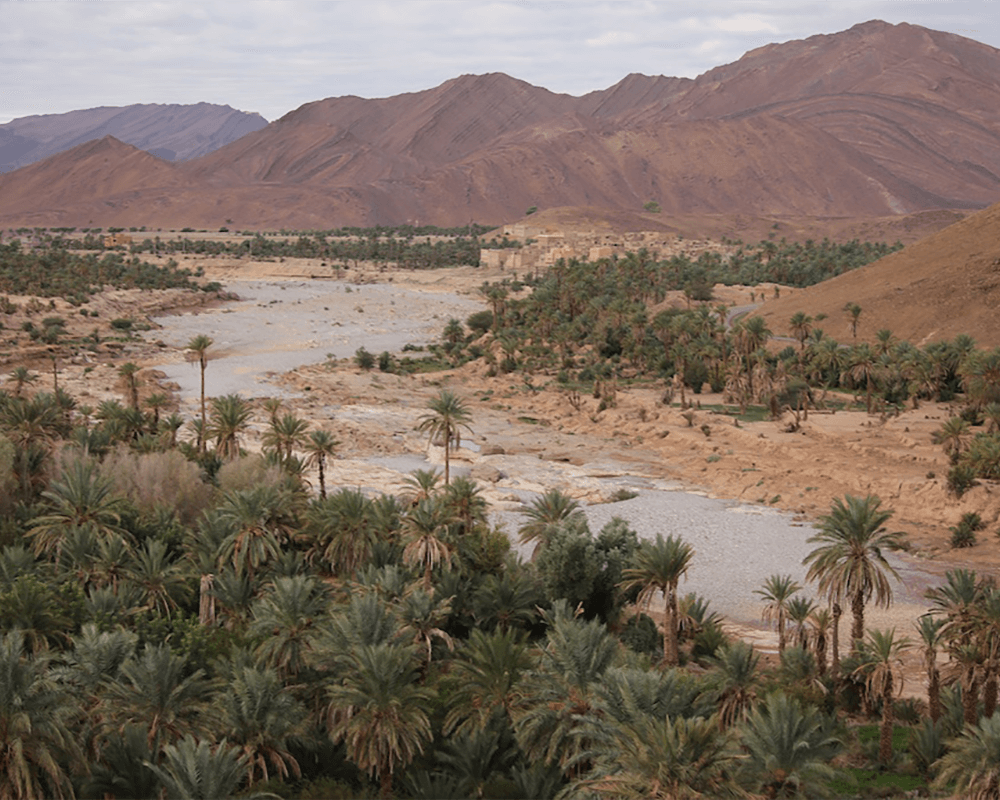To experience the Sahara in Morocco, you have to travel to the south-east of the country. Here, the Moroccan Sahara offers vast expanses, cultural treasures and breathtaking landscapes. A trip to this region reveals a diverse environment and offers a unique insight into the lives of the people who have been linked to the Sahara for centuries. For those who wish to immerse themselves in other cultures, the journey offers countless opportunities to discover new perspectives and embrace Morocco's rich diversity.
The adventure begins with the crossing of the High Atlas. Travelling over the Tizi n'Tichka pass, you will be treated to breathtaking views, often adorned with rainbows over the valleys - a taste of the magic that awaits you in the south.
The Draa Valley – An Oasis of Stories
Famous for its vast sea of palm trees and traditional mud-brick kasbahs, the Draa Valley is a true gem of the south. In Tamnougalt, an ancient Ksar settlement, you can discover architectural influences from Jewish, Moorish and Moroccan traditions. A stroll through its narrow streets, accompanied by stories of village life, reveals the history of a region deeply rooted in the Moroccan Sahara and once heavily dependent on agriculture.
Among the valley's gardens, towering palm trees invite visitors to stop and enjoy fresh dates straight from the tree - a simple but unforgettable treat.

Erg Chigaga – The Magic of the Moroccoan Desert
Continue to Erg Chigaga, where towering dunes meet the sky and the nomadic way of life comes into focus. After a rare rain, the area comes alive. A camel ride at sunset bathes the Moroccan Sahara in warm pinks and oranges - an unforgettable moment before spending the night in a traditional desert camp.
After a stunning sunrise, the journey continues to Foum Zguid and Tata. Here, a historic guesthouse overlooking a vast palm grove is the perfect place to relax and soak up the tranquillity of the south.
Tata – Tradition and Community
The palm grove at Tata is not only a stunning landscape, but also a place where centuries-old irrigation techniques are still in use. A visit to the central water tower provides an insight into how this precious resource is distributed - a skill that has sustained the community for generations.
Among the palm trees, travellers will find locals at work, whether transporting goods or harvesting dates. These dates, grown mainly for personal consumption, symbolise a deep connection with nature.
The Anti-Atlas – History and Views Over the Moroccan Sahara
From Tata, the journey continues to the foothills of the Anti-Atlas mountains. Here, perched on steep hillsides, are the centuries-old granaries known as agadirs. These structures tell the story of a time when families protected their crops from raiders by storing dates, olives and honey in small chambers. Climb to one of these granaries and you will be rewarded with sweeping views over the valley - a place where history comes alive.

© All photos via Mandy Sinclair
The Magic of the South
The Moroccan Sahara and the southern regions of the country enchant visitors with their blend of unspoilt nature, vibrant traditions and warm hospitality. From the palm groves of the Draa valley and the golden dunes of Erg Chigaga to the rocky peaks of the Anti-Atlas, a trip here will leave you with lasting memories.
The elusive allure of Morocco creates a deep-rooted desire to relive its magic. It is a country of cultural riches, breathtaking landscapes and genuine hospitality. A visit to the south of Morocco immerses travellers in a world of stories, traditions and breathtaking scenery - an adventure that lasts a long time and is best experienced through a well-planned Morocco Sahara tour. To complement the trip, there are countless other itineraries to discover the many facets of Morocco.






Share: